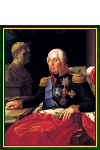Prince of Smolensk

The son of a military engineer from a Prussian family, Mikhail Illarionovich Golenichchev-Kutuzov was born on September 16, 1745 in St. Petersburg, where he received a solid education.
At the age of fourteen, in 1759, he graduated from the Dvorianstvo artillery school (a term used to designate the Russian nobility), and was promoted to commander of Empress Catherine II's Astrakhan infantry. He had his baptism of fire in Poland in 1764, serving throughout the campaign until 1769, then from 1770 fighting the Ottomans in the Russo-Turkish War of 1768-1774. He was seriously wounded in 1774, a bullet passing through his skull and causing the loss of his right eye. He was granted a year's leave of absence in 1776, which he spent traveling around Europe, attending courses at the University of Strasbourg.
In 1784, Kutuzov was appointed General Major. Under the command of Alexander Vasilyevich Suvorov, who was to become his master, he fought again against the Ottomans from 1788 to 1792, and was once again seriously wounded during the siege of Ochakov in 1788. He took part in the capture of Izmaïl in 1790, and rose through the ranks, becoming lieutenant-general in 1791, then commander of an army corps.
When peace came, Kutuzov successively held various administrative and diplomatic posts under Catherine II and then Paul 1: commander of the Ukraine, ambassador to Constantinople in 1795, governor-general of Finland, commander of the St. Petersburg cadet corps, ambassador to Berlin, military governor of St. Petersburg in 1801.
The years following the accession of Alexander I in March 1801 saw him sidelined from important posts (perhaps because he refused to take part in the plot to assassinate Paul I), but this all changed in 1805, during the third coalition against France. Alexander 1st could not do without the services of this experienced (he was sixty), cultured and cunning leader. He commissioned him to support the Austrians against Napoleon I.
Initially, Kutuzov successfully confronted Marshal Adolphe Edouard Casimir Mortier at Dürrenstein (or Dürnstein) on November 11, 1805. On the following December 2, he was at Austerlitz, where he advised Tsar Alexander I against battle. The latter disregarded his advice and, with the outcome we all know, made Kutuzov pay the price of having been right against him: the old general was once again relegated to second-rate posts and functions (Governor General of Lithuania and Kiev).
It wasn't until 1811 that Kutuzov once again distinguished himself in battle: he won several decisive victories against the Ottomans in Moldavia, enabling Russia to gain Bessarabia (Eastern Moldavia) under the Treaty of Bucharest on March 16, 1812. This earned him the dignities of prince, president of the state council and field marshal.
It was during the Russian campaign, for which Alexander I had entrusted him with the command-in-chief of the Russian army charged with countering the invasion of the country by the Grand Army, that Kutuzov became famous for both his strategic genius and his tactical acumen. For the first time in history, he applied the scorched-earth strategy on such a large scale, covering almost two thousand kilometers from the Russian border to Moscow [Moskva]. At the same time, as his troops retreated as the Grande Armée advanced, he launched incessant Cossack harassments against it. Finally, when Napoleon's troops approached Moscow, he chose the site of the battle: near the village of Borodino, for the disproportionate Battle of Borodino on September 7, 1812, which the French won, albeit at the cost of considerable losses.
He also took care to evacuate Moscow completely: when the French entered the capital, all they found was an empty city in flames (although it's not clear that the fire was part of Kutuzov's plan).
During Napoleon I's disastrous winter retreat, Kutuzov continued his strategy of harassment by small groups. The fighting at Dorogobouj and the battle of Krasnoy (near Smolensk), from November 15 to 18, earned Kutuzov the title of Prince of Smolensk and the Grand Cordon of St. George. When he crossed the Berezina on November 27-28, the remnants of the Grande Armée narrowly escaped his grasp.
Just as Kutuzov was about to take command of the allied forces of the Sixth Coalition, he succumbed to septicemia on April 6, 1813, at Bunzlau [Boleslawiec] in Silesia. He was buried in the Cathedral of Our Lady of Kazan in St. Petersburg.
"Mikhail Illarionovich Golenishchev-Kutuzov", by Roman Maximovich Volkov (? 1776 - ? 1831).

An equestrian statue of Kutuzov honors his memory on the eponymous Moscow avenue.
During the Second World War, the Order of Kutuzov was created by a decision of the Praesidium of the Supreme Soviet of the USSR on July 29, 1942, to honor senior officers of the Red Army. Today, it remains one of Russia's highest military honors.
All dates on this page are in the Gregorian calendar (then eleven and then twelve days ahead of the Julian calendar in use in Russia at the time).
In 1945, the Soviet Union Postal Service released a 30 Kopecks stamp bearing the image of Mikhail Illarionovich Golenishchev-Kutuzov , and the Russian Postal Service did so in 1995 with a 300 Rouble stamp .
Other portraits

Enlarge
"Mikhail Illarionovich Golenishchev-Kutuzov", by George Dawe (St James's, Westminster 1781 - Kentish Town 1829).

Enlarge
"Mikhail Illarionovich Golenishchev-Kutuzov, Prince of Smolensk", by Jozef Oleszkiewicz (Szydlowo, Poland, 1777 - Saint Petersburg 1830).